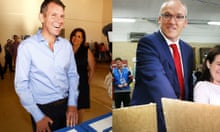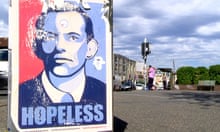Prominent Indigenous people say the 2015 New South Wales state election campaign has largely ignored Aboriginal issues, including the disproportionate impact of the Baird government’s cuts to services on Indigenous communities.
The former chief executive of the NSW Land Council, Geoff Scott, told Guardian Australia that Indigenous incarceration rates were “shocking” but had been “neglected across the board”.
Research from the Australian Bureau of Statistics released in December showed Indigenous incarceration rates around the country had increased 10% in the past year and were at the highest rate since 2004. Nearly a quarter of adult prisoners in NSW are Aboriginal or Torres Strait Islanders, despite only making up about 2% of the state’s population.
In an election questionnaire conducted by the NSW Law Society, the government said it would “continue to fund targeted programs” to reduce re-offending rates among adult Indigenous prisoners. It also pointed to a trial of the first NSW Youth Koori court as a sign of its commitment, and changes to the Kariong correctional centre near Gosford, which has been turned into a specialist prison to assist Aboriginal offenders.
Labor has promised $4m funding for “justice reinvestment” programs, based on a US model that uses data to identify communities particularly at risk of losing young men and women to prisons.
Targeted early intervention and diversionary programs would be set up in these communities and savings to the criminal justice system would be tracked and reinvested in these same programs.
The attorney general, Brad Hazzard, has indicated he is open to funding justice reinvestment programs, but said last month he had yet to receive any grant applications.
Many of the issues most important to Indigenous communities are not explicit Aboriginal policies, Larissa Behrendt, a law professor at the University Technology of Sydney, said.
“’Tough on crime’ policies, particularly things like bail reform, are often bad news for Indigenous communities,” she said.
Baird government cuts to services dealing with legal aid, domestic violence, women’s shelters and homelessness would also hit Indigenous communities hardest, she said.
The chairman of the Aboriginal Medical Service in Redfern, Sol Bellear, also noted the absence of Indigenous issues from the campaign. “Both major parties and the independents have been very quiet on Aboriginal issues, and on the issue of Aboriginal health, they’re doing nothing.”
Abuse of the drug crystal methamphetamine, commonly referred to as ice, was as much an issue in Indigenous communities as it was in the wider public, he said.
Bellear also said he had seen a “very big increase” in juvenile diabetes among Aboriginal children he treated, but said a holistic approach was needed to address the causes, including programs educating parents on nutrition and health.
The final week of the campaign saw the premier, Mike Baird, make his first headline Aboriginal affairs announcement – up to $20m to establish an Aboriginal centre for excellence in western Sydney, modelled on a similar facility in Redfern.

It will serve the more than one-fifth of the state’s Aboriginal population who reside in Sydney’s west, which has the highest total Indigenous population of any region in the country.
Around $12m from a package of new money for counsellors and student support officers has been set aside to assist Aboriginal and refugee students. Meanwhile the government has funded a new mobile app that aims to sustain and revitalise five local Aboriginal languages, at a cost of about $185,000.
Memorials to the three children killed in the infamous Bowraville murders will soon be upgraded, according to Aboriginal affairs minister Victor Dominello.
An October inquiry into the killings of Colleen Walker-Craig, Evelyn Greenup and Clinton Speedy-Duroux also recommended legal changes that could see their suspected killer face justice. Whichever party forms government on Saturday will have until May this year to respond to those recommendations.
Apart from its $4m initiative to tackle Aboriginal incarceration rates, Labor will also hand control of Goat Island in Sydney harbour to the NSW Aboriginal Land Council.
The 300m-wide island, also known as Me-mel, was recorded in the diary of an arrival of the first fleet as belonging to Bennelong and his wife Barangaroo, members of the Wangal people of the Eora nation.
Labor has also promised to build an Indigenous cultural centre at the Barangaroo site on Sydney harbour.
The issue of land rights flared briefly last November when the state planning minister, Kevin Humphries, sought to ban Aboriginal communities from making land claims on coastal areas.
The policy, which Humphries said was aimed at ensuring free access to beaches, would also have cancelled 1,800 outstanding land claims to beachfront lands.
It was slammed as racist and unnecessary – in each successful claim to beachfront land an easement had been granted allowing public access to the water – and was temporarily shelved by the Baird government. Labor had asked that it be scrapped altogether.
The removal of children by state welfare authorities has increased fivefold in the past 20 years and rates are highest in NSW. One in 10 Aboriginal children in the state have been removed from their parents, and one pressure group, Grandmothers Against Removals (GAR), has warned of an “ongoing stolen generation”.
Since 2011, the Baird government has trialled a program in Moree and Shellharbour that involves Aboriginal welfare organisations in the child protection process to ensure “the cultural and individual needs of families” are met and children can be placed with extended family if possible.
GAR has proposed a similar model that focuses on keeping families together and wants the program expanded statewide.
Scott, who now heads the National Congress of Australia’s First Peoples, said the government deserved praise for the Connected Communities initiative, which saw 15 schools in communities with high Indigenous populations become community hubs that employed Aboriginal elders and embedded Aboriginal culture and language into the curriculum.









Comments (…)
Sign in or create your Guardian account to join the discussion